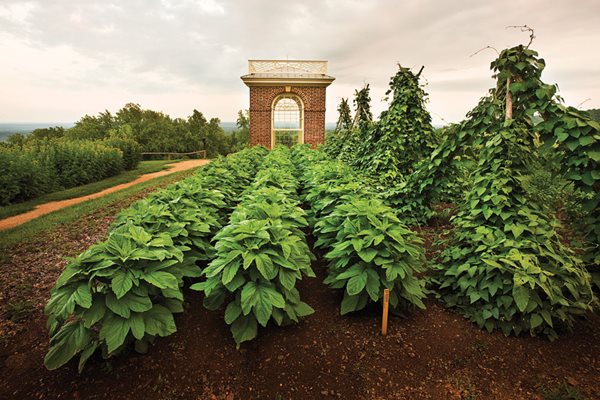Thomas Jefferson's Monticello, Photo Gallery
April 13th marked the 271st birthday of the 3rd President of the United States, Thomas Jefferson. Monticello in Charlottsville, Virginia—Jefferson’s bountiful gardens, which he tended with famous enthusiasm—is still shared with the public today. If you're interested in visiting Monticello, find more information here.

Thomas Jefferson was a passionate plantsman—an epicure. For decades, the 1,000-foot-long, 80-foot-wide terraced vegetable garden at Monticello was unattended and covered by layers of dirt. It was known only through writings until archaeologists began its excavation in the late 1970s. Peter Hatch, whose official title was director of gardens and grounds at Monticello until he retired, transformed it into a thriving approximation of Jefferson’s own experimental garden on his plantation estate in Charlottesville, Virginia.
Monticello’s garden now features tansy, ‘Green Globe’ artichoke, scarlet runner beans (on the poles), tree onions, and tomatoes (on the trellis), shown here.

Jefferson was fond of sesame, which is shown growing here (on the left). He also grew ‘Red Calico’ lima beans (on the right). After sampling sesame oil, he wrote, “This is among the most valuable acquisitions our country has ever made.” He grew it for decades, but it is not commonly farmed here today.

The experimental character of Jefferson’s garden was reflected in the corn varieties he tested, many of which were collected by Lewis and Clark from northern plains Indian tribes.

Thomas Jefferson tended the vegetable garden at Monticello with famous verve, exchanging seeds with correspondents across the world and continuously experimenting with plants to see if and how they would grow in Charlottesville's climate and soil.
Jefferson also adored carrots and established a yearly quota of 10 bushels for the plantation garden. The root vegetable—orange as well as yellow—was featured in numerous dishes at Monticello, including porridge.
Dacus carota is pictured here.

Many of his planting decisions were driven by his appetite. He liked beer and hired Joseph Miller, a brewer originally from Great Britain, to make an ale specifically for Monticello. At first, Jefferson bought hops and malt, the main ingredients of the beer, from neighbors. Eventually, he grew hops himself and made the malt from Indian corn cultivated in the Monticello garden.
Humulus Lupulus, an ingredient in many beers, is pictured here.

Legumes were an ongoing obsession for Jefferson, and he grew many varieties, including kidney, lima, and caracalla beans. He was particularly fond of the English pea, and it became a Jeffersonian icon. Neighbors would grow them to have on hand to offer to Jefferson if he visited; they would also have competitions to see who could harvest the first peas of the season. His fascination with peas was documented in his journals, where he noted when they sprouted from the ground, the dates they flowered, and the day on which the season's first pod formed.
Phaseolus Lunatus is pictured here.

This slide show is part of a previous Garden Design article, which can be found here.
Cucumis sativus is pictured here.




